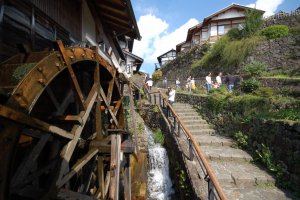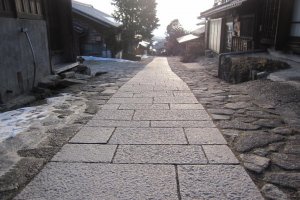The drive, heading out from Nakatsugawa, took us up and through winding hills, eventually bringing us to signs pointing to the Nakasendo and on up the hill to Magome. We stopped off at the remains of the original Nakasendo at Ochiai before beginning on the slow curvy paved road, which is still a part of what was once the original Nakasendo, winding our way high into the hills until we arrived in the very busy town of Magome.
What allows this heavily visited tourist attraction to remain very worth the trip to see is that although very clearly into the tourist trade, the maintenance and appearances of a very old town provide a very special view of what must have been as busy a place in olden times as it is, today. Modern buildings are forbidden in Magome; everything must reflect the image of the community.
Getting into the main area of Magome is what really adds to any sense of what an adventure can bring. There are parking lots on the perimeter but if you are not a resident of the town, you cannot drive down the main road. It is not a hinderance, in fact it is a blessing as we had to navigate the town on foot to really get engaged in the place. Picking up at the foot of the hill where the Nakasendo came into the village, that road, as it were, now becomes a real challenge for it rises up and up and up, climbing ever onward as one would move from Magome, the 43rd station of sixty-nine, onto the next village in the long string of post towns between Edo (Tokyo) and Kyoto.
After a traditional Japanese lunch of buckwheat noodles, pickled daikon, slaw and fish topped off by a local speciality of chestnut soft-serve ice cream we began our main exploration of the town.
The steep road is lined with minshuku and shops selling local foods, crafts and souvenirs. One of the first buildings and one of the main symbols of the town is an old mill with two water wheels which had been used to make rice flower but today actually produces some hydro-electric energy for the town.
Further up the road is the birthplace and childhood home of Toson Shimazaki, author of “Before the dawn”, an historical novel portraying the fall of the Tokugawa Shogunate and the beginning of the Meiji Restoration. Today it is a museum telling the story of his life and his writings. He is buried in the town’s cemetery.
At the top of the hill, the road continues north on to Tsumago, the other towns of the Nakasendo connecting all the way to Nihonbashi. But we turned around and at that point looking south on the panoramic view of the Kiso valley could imagine ourselves as travelers on our way to Kyoto. After trekking over the Kiso mountains and through deep valleys we would come to the top of a rise to be greeted by Mt Ena, the Kiso river, the Mino Plains; welcomed to rest at Magome-juku with the knowledge that we were only half-way to Kyoto.

































634957591: This is a cool place. In summer Magome can be cool as it is on the top of a mountain. There are a few Minshuku that are very popular with foreigners. A popular location with city folk in Nakatsugawa is Kashimo. You can rent cabins, go hiking in the mountains, swimming in the river, visit artisans and onsen in Gero. I hope to get information up about one cabin rental that is really really nice (comes with a garden). The temp in Kashimo is usually around 26/27 but can get up to 30. But since it is in the mountains, you don't need air conditioning and at night you will need a blanket.
https://en.japantravel.com/gifu/kashimo/1556